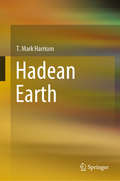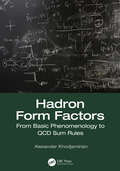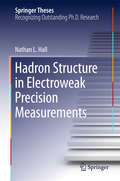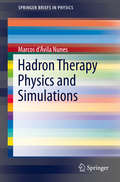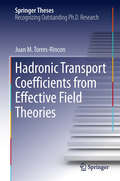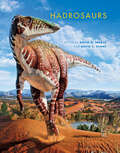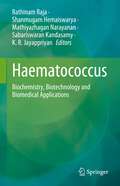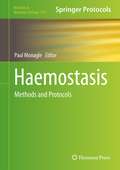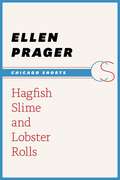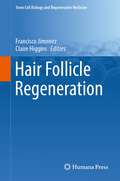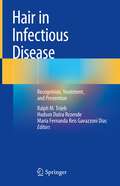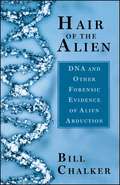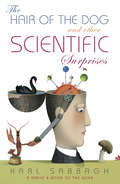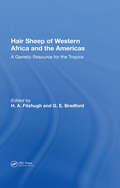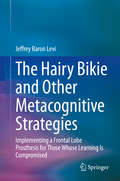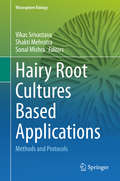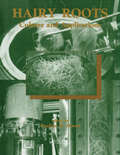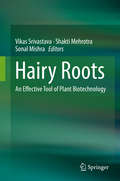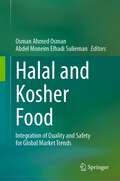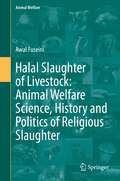- Table View
- List View
The Hadal Zone
by Alan JamiesonThe hadal zone represents one of the last great frontiers in marine science, accounting for 45% of the total ocean depth range. Despite very little research effort since the 1950s, the last ten years has seen a renaissance in hadal exploration, almost certainly as a result of technological advances that have made this otherwise largely inaccessible frontier, a viable subject for research. Providing an overview of the geology involved in trench formation, the hydrography and food supply, this book details all that is currently known about organisms at hadal depths and linkages to the better known abyssal and bathyal depths. New insights on how, where and what really survives and thrives in the deepest biozone are provided, allowing this region to be considered when dealing with sustainability and conservation issues in the marine environment.
Hadean Earth
by T. Mark HarrisonThis book consolidates the latest research on the Hadean Eon - the first 500 million years of Earth history - which has permitted hypotheses of early Earth evolution to be tested, including geophysical models that include the possibility of plate tectonic-like behavior. These new observations challenge the longstanding Hadean paradigm – based on no observational evidence - of a desiccated, lifeless, continent-free wasteland in which surface petrogenesis was largely due to extraterrestrial impacts. The eon was termed “Hadean” to reflect such a hellish environment. That view began to be challenged in 2001 as results of geochemical analyses of greater than 4 billion year old zircons from Australia emerged. These data were consistent with the zircons forming in a world much more similar to today than long thought and interpreted to indicate that sediment cycling was occurring in the presence of liquid water. This new view leaves open the possibility that life could have emerged shortly after Earth accretion. The epistemic limitations under which the old paradigm persisted are closely examined. The book is principally designed as a monograph but has the potential to be used as a text for advanced graduate courses on early Earth evolution.
Hadron Form Factors: From Basic Phenomenology to QCD Sum Rules
by Alexander KhodjamirianThis book introduces the phenomenology and theory of hadron form factors in a consistent manner, deriving step-by-step the key equations, defining the form factors from the matrix elements of hadronic transitions and deriving their symmetry relations. Explained are several general concepts of particle theory and phenomenology exemplified by hadron form factors. The main emphasis here is on learning the analytical methods in particle phenomenology. Many examples of hadronic processes involving form factors are considered, from the pion electromagnetic scattering to heavy B-meson decays. In the second part of the book, modern techniques of the form factor calculation, based on the method of sum rules in the theory of strong interactions, quantum chromodynamics, are introduced in an accessible manner. This book will be a useful guide for graduate students and early-career researchers working in the field of particle phenomenology and experiments. Features: • The first book to address the phenomenology of hadron form factors at a pedagogical level in one coherent volume • Contains up-to-date descriptions of the most important form factors of the electroweak transitions investigated in particle physics experiments
Hadron Structure in Electroweak Precision Measurements
by Nathan L. HallThis thesis examines the γZ box contribution to the weak charge of the proton. Here, by combining recent parity-violating electron-deuteron scattering data with our current understanding of parton distribution functions, the author shows that one can limit this model dependence. The resulting construction is a robust model of the γγ and γZ structure functions that can also be used to study a variety of low-energy phenomena. Two such cases are discussed in this work, namely, the nucleon's electromagnetic polarizabilities and quark-hadron duality. By using phenomenological information to constrain the input structure functions, this important but previously poorly understood radiative correction is determined at the kinematics of the parity-violating experiment, QWEAK, to a degree of precision more than twice that of the previous best estimate. A detailed investigation into available parametrizations of the electromagnetic and interference cross-sections indicates that earlier analyses suffered from the inability to correctly quantify their model dependence.
Hadron Therapy Physics and Simulations
by Marcos D'Ávila NunesThis brief provides an in-depth overview of the physics of hadron therapy, ranging from the history to the latest contributions to the subject. It covers the mechanisms of protons and carbon ions at the molecular level (DNA breaks and proteins 53BP1 and RPA), the physics and mathematics of accelerators (Cyclotron and Synchrotron), microdosimetry measurements (with new results so far achieved), and Monte Carlo simulations in hadron therapy using FLUKA (CERN) and MCHIT (FIAS) software. The text also includes information about proton therapy centers and carbon ion centers (PTCOG), as well as a comparison and discussion of both techniques in treatment planning and radiation monitoring. This brief is suitable for newcomers to medical physics as well as seasoned specialists in radiation oncology.
Hadronic Transport Coefficients from Effective Field Theories
by Juan M. Torres-RinconThis dissertation focuses on the calculation of transport coefficients in the matter created in a relativistic heavy-ion collision after chemical freeze-out. This matter can be well approximated using a pion gas out of equilibrium. We describe the theoretical framework needed to obtain the shear and bulk viscosities, the thermal and electrical conductivities and the flavor diffusion coefficients of a meson gas at low temperatures. To describe the interactions of the degrees of freedom, we use effective field theories with chiral and heavy quark symmetries. We subsequently introduce the unitarization methods in order to obtain a scattering amplitude that satisfies the unitarity condition exactly, then go on to calculate the transport properties of the low-temperature phase of quantum chromodynamics - the hadronic medium - which can be used in hydrodynamic simulations of a relativistic heavy-ion collision and its subsequent evolution. We show that the shear viscosity over entropy density exhibits a minimum in a phase transition by studying this coefficient in atomic Argon (around the liquid-gas phase transition) and in the linear sigma model in the limit of a large number of scalar fields (which presents a chiral phase transition). Finally, we provide an experimental method for estimating the bulk viscosity in relativistic heavy-ion collisions by performing correlations of the fluctuating components of the stress-energy tensor.
Hadrons at Finite Temperature
by Samirnath Mallik Sourav SarkarHigh energy laboratories are performing experiments in heavy ion collisions to explore the structure of matter at high temperature and density. This elementary book explains the basic ideas involved in the theoretical analysis of these experimental data. It first develops two topics needed for this purpose, namely hadron interactions and thermal field theory. Chiral perturbation theory is developed to describe hadron interactions and thermal field theory is formulated in the real-time method. In particular, spectral form of thermal propagators is derived for fields of arbitrary spin and used to calculate loop integrals. These developments are then applied to find quark condensate and hadron parameters in medium, including dilepton production. Finally, the non-equilibrium method of statistical field theory to calculate transport coefficients is reviewed. With technical details explained in the text and appendices, this book should be accessible to researchers as well as graduate students interested in thermal field theory.
Hadrosaurs (Life Of The Past Ser.)
by James O. FarlowHadrosaurs--also known as duck-billed dinosaurs--are abundant in the fossil record. With their unique complex jaws and teeth perfectly suited to shred and chew plants, they flourished on Earth in remarkable diversity during the Late Cretaceous. So ubiquitous are their remains that we have learned more about dinosaurian paleobiology and paleoecology from hadrosaurs than we have from any other group. In recent years, hadrosaurs have been in the spotlight. Researchers around the world have been studying new specimens and new taxa seeking to expand and clarify our knowledge of these marvelous beasts. This volume presents the results of an international symposium on hadrosaurs, sponsored by the Royal Tyrrell Museum and the Royal Ontario Museum, where scientists and students gathered to share their research and their passion for duck-billed dinosaurs. A uniquely comprehensive treatment of hadrosaurs, the book encompasses not only the well-known hadrosaurids proper, but also Hadrosaouroidea, allowing the former group to be evaluated in a broader perspective. The 36 chapters are divided into six sections--an overview, new insights into hadrosaur origins, hadrosaurid anatomy and variation, biogeography and biostratigraphy, function and growth, and preservation, tracks, and traces--followed by an afterword by Jack Horner.
Haematococcus: Biochemistry, Biotechnology and Biomedical Applications
by Rathinam Raja Shanmugam Hemaiswarya Mathiyazhagan Narayanan Sabariswaran Kandasamy K. R. JayappriyanThis book offers a comprehensive analysis of microalgal cultivation methods and optimization of astaxanthin production for various applications, including clinical uses, algae polymers, proteins and pigments, food applications and packaging, algae forming, cosmetics, and more. Microalgae are unicellular living forms and are the primary producers that play a major role in the ecosystem. Commercially, while many documents are available, some recent fields are yet to be explored. The book comprises 19 chapters contributed by experts and reviews the recent developments in the cultivation, harvest, and genetic engineering of H. pluvialis-derived astaxanthin. It also discusses their bottlenecks and challenges in commercial-scale production, as well as current and prospective global market. Current research supports the exploration of new topics and practical applications of microalgae and their products, which will also benefit academia. The book will be an important resource for researchers and industry, providing comprehensive knowledge on broad topics. Flow charts, updated methods, and colour images are included to help the readers' understanding.
Haemorrhage and Thrombosis for the MRCOG and Beyond
by Ann HarperAlthough disorders of the coagulation system are uncommon in pregnancy, the two main hazards - haemorrhage and thromboembolism - are leading causes of direct maternal death in the UK and worldwide. Gynaecologists may encounter abnormal haemostasis as a cause of intractable menorrhagia or perioperative haemorrhage, and thromboembolism is a significant risk for women undergoing major gynaecological surgery. This book brings together various aspects of haemostasis in relation to obstetrics and gynaecology to provide practical guidance to clinicians, who may only occasionally encounter these problems. Emphasis is placed on the need for good working relationships and close liaison between obstetricians and gynaecologists, anaesthetists, haematologists and blood transfusion services. The book is primarily designed to provide a comprehensive summary for candidates preparing for the Part 2 MRCOG examination, and as such covers the RCOG curriculum for haemorrhage and thrombosis. It is also a valuable guide for all healthcare professionals working in the field.
Haemostasis
by Paul MonagleThe haemostatic system is one the most important physiological systems for maintaining health and well being, and thus the investigation of the haemostatic system remains a research priority. Disturbances of the haemostatic system in the broader sense, such as heart disease and strokes, arguably constitute the single greatest contribution to non-infectious mortality in the world today. Therefore, understanding the laboratory methods to assess the haemostatic system is vital for the practice of complex clinical medicine. In Haemostasis: Methods and Protocols, experts in the field address the major components of the haemostatic system, general principles of haemostatic testing, and techniques used to assess various aspects of the haemostatic system, grouped according to their functional indications. Written in the successful Methods in Molecular BiologyTM series format, chapters include introductions to their respective topics, lists of the necessary materials and reagents, step-by-step, readily reproducible protocols, and notes on troubleshooting and avoiding known pitfalls. Authoritative and easily accessible, Haemostasis: Methods and Protocols provides an ideal guide to scientists of all backgrounds and serves an urgent need for further research to develop superior methods of assessing the haemostatic system in humans.
Hagfish Slime and Lobster Rolls
by Ellen PragerWhen viewed from a quiet beach, the ocean, with its rolling waves and vast expanse, can seem calm, even serene. But hidden beneath the sea's waves are a staggering abundance and variety of active creatures, engaged in the never-ending struggles of life--to reproduce, to eat, and to avoid being eaten. With Hagfish Slime and Lobster Rolls, marine scientist Ellen Prager takes us deep into the sea to introduce an astonishing cast of fascinating and bizarre creatures that make the salty depths their home, with the help of stunning color photos. From the lobsters that battle rivals or seduce mates with their urine to hagfish that ties itself into a knot to keep from suffocating in its own slime--there's far more to Prager's account than her ever-entertaining anecdotes. Again and again, she illustrates the crucial connections between life in the ocean and humankind, enchanting us as she educates, enthralling us with the wealth of life in the sea, and reminding us of our need to protect it.
Hair Follicle Regeneration (Stem Cell Biology and Regenerative Medicine #72)
by Francisco Jimenez Claire HigginsThis book aims to comprehensively review the current cell-based strategies under investigation to achieve the regeneration of human hair follicles. The unique capacity of the human hair follicle to self-renew explains why this complex “mini-organ” has always attracted so much interest as a model for researchers to study stem cell biology and regenerative medicine. The hair follicle is considered a main reservoir of cutaneous stem cells, containing several pools of epithelial, melanocyte, and mesenchymal stem cells involved in hair follicle self-regeneration and pigmentation. In addition, while some of the different follicular cell types contribute to hair shaft growth, others participate in very important interfollicular functions such as dermal remodeling, re-epithelialization after wounding, and cutaneous stem cell homeostasis. The idea of human hair follicle regeneration either “de novo” or by activating dormant miniaturized follicles is not new, yet still continues to arouse enormous interest in the pursuit of a definitive cure for baldness. In contrast to hair follicle regeneration in mice, the attempts made with human follicles have been disappointing in terms of efficiency. However, recent advances in stem cell biology—as well as the appearance of new technologies like 3D printing—have revived expectations in this field of research. This book is divided into four sections. The first part includes an overview of the strategies used in hair follicle regeneration and a historical summary of the most important achievements to date. Parts two and three comprise the main body of the book, with detailed descriptions of the cells and tissue structures involved in hair follicle regeneration, followed by an elaboration of the different therapeutic strategies, engineering techniques, and a clinician’s perspective of stem cell-based therapies in hair loss treatments. Finally, the fourth part reviews the important contribution of the hair follicle in healing cutaneous wounds through the regeneration and remodeling of the dermis and epidermis after injury, as well as wound induced hair follicle neogenesis that occurs when the skin is injured.
Hair in Infectious Disease: Recognition, Treatment, and Prevention
by Ralph M. Trüeb Hudson Dutra Rezende Maria Fernanda Reis Gavazzoni DiasThe novel viral pandemic coronavirus disease 2019 (COVID-19) has sparked uncertainties and controversies as to its origin, epidemiology, and natural course. In this situation, the medical disciplines have strived to contribute to a better understanding of the disease with the best available evidence gained from the scientific method of observation and statistics. The study of the cutaneous manifestations of COVID-19 has evolved with the hope that they may be useful as markers for the disease, for prognostication, and further insights into the pathogenesis of the disease manifestations. In the wake of COVID-19, we have decided to take a more general look at the hair and scalp in infectious disease. Specifically, we must recognize that infectious diseases have wider preconditions besides the infectious agents, to include environmental and societal factors. Unless we also take account of the ecological, immunological, and behavioral circumstances that affect the emergence and spread of infectious diseases, including those of the hair and scalp, our knowledge of the pathogens and their connection to clinical disease presentation remain only partial and incomplete. This book aims at illustrating in detail the environmental and individual preconditions, the pathogens, the clinical presentations, and the management of the infectious diseases that affect the hair and scalp, to include superficial and deep bacterial, fungal, and viral infections, infestations, systemic infectious diseases causing hair loss, their effective treatment, and their prevention. Hair in Infectious Disease offers a complete overview of infectious hair disease and guides the practitioner in the choice of the best treatment; it will be a valued companion to board-certified dermatologists and dermatologists in training.
Hair of the Alien: DNA and Other Forensic Evidence of Alien Abductions
by Bill ChalkerShocking. Controversial. Unprecedented. A case unlike any other in the annals of UFO investigation, DNA research, or alien abduction. Sydney, Australia. July 23, 1992. Twenty-eight-year-old Peter Khoury was awoken by what appeared to be two females -- both striking and unearthly -- kneeling on his bed. What transpired between them was a physical assault as bizarre and disorienting as it was unnatural. Then, as quickly as they had arrived, they vanished. Khoury had become one of a legion of alien abductees with inexplicable experiences, but this particular incident stood apart from all the others. This time, there was evidence -- two strands of white-blonde hair from one of the females. Khoury's case would result in the very first forensic DNA analysis of "alien abduction" evidence and revealed an extraordinary biological anomaly -- one genetically close to human yet almost impossibly far from the human mainstream. A gripping account of one of the great mysteries of our time, Hair of the Alien brings us closer than ever before to understanding our past, our origins, and our place in the universe. The results are nothing less than startling.
The Hair of the Dog: And Other Scientific Surprises
by Karl SabbaghScience is full of surprises: the peculiar peepshow beginnings of baby incubators; the unexpected positive fallout from the H-bomb; the dinosaurs that caused sonic booms; the irrational nature of the number pi; the fifth taste sensation lurking in everyone's taste buds which nobody knew about (except for the Japanese). Whilst shedding light on these conundrums, Karl Sabbagh shows that seemingly trivial queries or assumptions lead to a deeper understanding of how science works. Who would have thought that scientists would turn to the hypothesis 'All swans are white' to determine the stability of the entire universe? Or that if we choose to spend our hard-earned money on other people it might make us happier than if we spend it on ourselves?
The Hair of the Dog: And Other Scientific Surprises
by Karl SabbaghScience is full of surprises: the peculiar peepshow beginnings of baby incubators; the unexpected positive fallout from the H-bomb; the dinosaurs that caused sonic booms; the irrational nature of the number pi; the fifth taste sensation lurking in everyone's taste buds which nobody knew about (except for the Japanese). Whilst shedding light on these conundrums, Karl Sabbagh shows that seemingly trivial queries or assumptions lead to a deeper understanding of how science works. Who would have thought that scientists would turn to the hypothesis 'All swans are white' to determine the stability of the entire universe? Or that if we choose to spend our hard-earned money on other people it might make us happier than if we spend it on ourselves?
Hair Sheep Of Western Africa And The Americas: A Genetic Resource For The Tropics
by H. A. FitzhughPerhaps less than 10 percent of the world's sheep have hair coats instead of wool fleeces, but as an animal resource, these sheep are important far out of proportion to their numbers. Hair coats provide an advantage in the face of the heat, humidity, and other stresses of the tropics. Small in body size, early to mature, and often highly prolific,
The Hairy Bikie and Other Metacognitive Strategies: Implementing a Frontal Lobe Prosthesis for Those Whose Learning Is Compromised
by Jeffrey Baron LeviThe book contains practical and innovative strategies to train clients with Traumatic Brain Injury, Autism, Intellectual Impairment and Behavioural Disorders to compensate for their deficits and to function independently within their environments. The book is a result of 30 years of working directly with clients who are experiencing problems with organization, memory, learning, problem solving and anger management. The book is highly recommended for practitioners working with clients with a range of disability in educational, community or work settings and is a valuable tool to researchers and tertiary institutions to impart this knowledge to future practitioners. The book is highly recommended to be included in a cognitive rehabilitation course for counsellors, neuropsychologists, rehabilitation consultants and vocational rehabilitation consultants. It would be highly relevant for a section in a Special Education course and for school psychologists, special education and mainstream teachers working with children with learning and behavioural disorders.
Hairy Root Cultures Based Applications: Methods and Protocols (Rhizosphere Biology)
by Vikas Srivastava Shakti Mehrotra Sonal MishraThe book discusses the various methods and protocols available in hairy root culture-based research. The utilization of Agrobacterium mediated genetic transformation and establishment of hairy root cultures has paved the way for large-scale secondary metabolite production in medicinal plants. Presenting recent research and offering insights from eminent research groups, the book covers a range of topics related to hairy root-based applications, including (i) establishment of hairy roots and native production of SM (ii) yield enhancement strategies for increased SM production, like elicitation (iii) hairy roots as a tool for value-added applications such as plant-microbe interaction, characterization of plant genes and root biology studies. As such it is an informative guide and experimental manual for researchers in diverse fields of plant biology.
Hairy Roots
by Pauline M. DoranHairy roots are plant roots that have been genetically transformed and can be cultured on a large scale. They can replace the whole plant in many research projects, and offer a range of technical advantages over plant cell cultures. Hairy roots are now used in studies of plant secondary metabolism and its genetic manipulation, as hosts for the production of foreign proteins, for plant propagation in agriculture, in environmental research, and for the development of new engineering technology for large-scale production of plant chemicals. Hairy root culture is an interdisciplinary science, with important and expansive applications. This volume is the first to be dedicated solely to the many facets of hairy root culture. The number of papers dedicated to hairy roots is rising exponentially, and with the increasing amount of research already underway this forms a timely publication. It is written and edited by acknowledged experts in the areas of hairy root culture and product synthesis, plant propagation, bio-processing and environmental aspects of hairyroots.
Hairy Roots: An Effective Tool of Plant Biotechnology
by Vikas Srivastava Shakti Mehrotra Sonal MishraThe growing scale of plant-based chemicals for industrial use has generated considerable interest in developing methods to meet their desired production levels. Among various available strategies for their production, the development of Agrobacterium rhizogenes mediated hairy root cultures (HRCs) is generally considered the most feasible approach. Additionally, several proof-of-principle experiments have demonstrated the practical feasibility of HRCs in the plant-based remediation of environment pollutants, biotransformation of important compounds, and production of therapeutic proteins. Given that hairy root biotechnology has now been recognized as a promising and highly dynamic research area, this book offers a timely update on recent advances, and approaches hairy roots as a multifaceted biological tool for various applications. Further, it seeks to investigate the loopholes in existing methodologies, identify remaining challenges and find potential solutions by presenting well thought-out scientific discussions from various eminent research groups working on hairy root biotechnology. This book provides detailed conceptual and practical information on HRC-based research, along with relevant case studies. The content is divided into three broad sections, namely (i) Hairy Roots and Secondary Metabolism, (ii) Progressive Applications, and (iii) Novel Approaches and Future Prospects. By informing the research and teaching community about the major strides made in HRC-based interventions in plant biology and their applications, the book is sure to spark further research in this fascinating field.
Halal and Kosher Food: Integration of Quality and Safety for Global Market Trends
by Osman Ahmed Osman Abdel Moneim Elhadi SuliemanIn both Islamic and non-Islamic countries many population groups worldwide, such as vegetarians and people of the Jewish faith, consumers do not eat pork. Amongst these groups consumers are concerned about importing processed food which may contain or has been contaminated with pork or swine-derived products. This is especially true of halal foods in Muslim communities where the foods may be prepared or processed utilizing one of more non-halal ingredients. Halal and kosher foodstuff play an incredibly important role in the Muslim and Jewish diet, economy and health. This makes halal and kosher food product quality, safety and shelf life preservation a major topic in these communities and for the manufacturers of halal and kosher food products. Halal and Kosher Food: Integration of Quality and Safety for Global Market Trends covers a wide range of important topics in halal foods including quality, standards, safety of food additives, antimicrobial and veterinary drug residues, aflatoxin in feedstuff, application of Hazards Analysis and critical Control Points (HACCP). Important data regarding halal and kosher food similarities and differences are covered in full. Best practices in halal food product manufacturing are covered, plus the importance of halal food safety for consumer health. Written by elite international halal food experts, this work differs from other books on the subject which focus on history, legislation and certification. Readers can utilize this book as an orientation and practical guidebook to recognize the quality and safety of halal food products.
Halal Slaughter of Livestock: Animal Welfare Science, History and Politics of Religious Slaughter (Animal Welfare #22)
by Awal FuseiniThis unique volume gives insight into the science of slaughter with in-depth discussion of neural communication and the welfare aspects of pre-slaughter handling and slaughter of livestock. The concepts of conscious perception, unconsciousness, stunning, slaughter and death are discussed to provide readers with an understanding of the different events that lead to the conversion of animals into carcasses and subsequently into meat. This accessible work is an excellent resource for learning about welfare issues of different techniques, as it includes historical aspects of religious and conventional slaughter with a focus on the developments around technologies. It comprises the advent of mechanical slaughter in the form of poleaxes to present day use of sophisticated stunning equipment.Moreover, the author covers key aspects of halal meat production and discusses the politics of religious slaughter with an emphasis on the increasing number of anti-halal movements across Europe, America and others. The slaughter of animals for consumption by people of faith is economically significant and has led to a race for market share by multinational retail enterprises. However, there are also ethical and political aspects of religious slaughter which have always divided opinion.The topic of this book provides an important link to the disciplines of animal welfare research, the meat industry and the food business. Scientists, students, as well as government agencies, veterinarians and professionals in food processing and slaughter technology manufacturing will find this an important account. Simplified summaries and practical notes make this reference highly readable.
Halbzeit der Energiewende?: An der Schwelle in eine neue Energiegesellschaft
by Josef GochermannIst die Energiewende steckengeblieben oder gar gescheitert? Haben Regulierung und Politik den Wandel zum nachhaltigen Umgang mit Energie ausgebremst? Verschläft die Wirtschaft die Wende? Nein, ganz und gar nicht. Während vielen die Energiewende nicht schnell genug vorankommt, befinden wir uns bereits auf der Schwelle in eine neue Energiegesellschaft. Die Energiewende ist Teil eines größeren Wandlungsprozesses. Ein Wandel im Umgang mit Energie, ihrer Gewinnung und ihres Wertes, Teil der laufenden vierten industriellen Revolution und viel mehr als nur der Umstieg auf regenerative Energien. Dieser Wandel vollzieht sich quer durch alle Bereiche der Wirtschaft und der Gesellschaft, baut die Energiewirtschaft um, verändert die Mobilität und initiiert dezentrale Lösungen in Unternehmen und Städten und Gemeinden. Das Buch richtet sich an alle, die sich am Umbau des Energiesystems beteiligen wollen, Unternehmen und Organisationen sowie auch der Politik.

